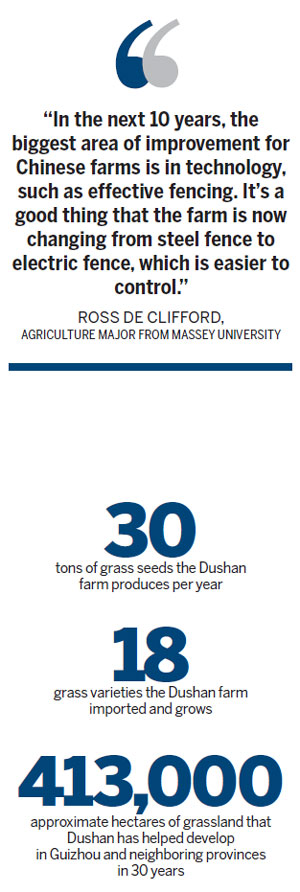Pastures are now alive
Updated: 2013-11-29 09:49
By Sun Yuanqing (China Daily)
|
||||||||

Thirty years ago, this was a barren wasteland. Now, Dushan county is a provincial promoter of pasture technologies. Sun Yuanqing reports.
The slopes are boundless and the grass is flourishing. With the mooing and bleating, one could easily mistake this grazing pasture in Dushan county, Guizhou province in Southwest China for a farm in New Zealand.
The milk tastes the part too. This is actually one of the few places in China where you can taste fresh milk produced by cows that run free 24 hours a day.
A barren wasteland 30 years ago, Dushan demonstrates how New Zealand experience can be applied in Southwest China, which has one of the most typical karst landscapes in the world.
"People thought it impossible to develop pasture and husbandry here, but we have proven them wrong," says Zhang Buyun, chairman of the labor union of the Dushan Pastoral and Seed Demonstration Farm. He has witnessed and taken part in the endeavor to change Dushan from a rocky deserted land to one of China's best grazing pastures.
It is estimated that more than 40 percent of the land, or 320,000 square kilometers, in Guizhou and Yunnan provinces and the Guangxi Zhuang autonomous region, suffers from stony desertification. Forests and grassland in the fragile karst area were set on fire and transformed into farmland to feed more people, causing natural hazards, low fertility and eventually poverty.
Best breeds
Over the past two decades, the Dushan farm has developed from a local seed provider to a provincial promotional center of pasture technologies in Guizhou and the neighboring provinces.
Every year, the Dushan farm produces 30 tons of grass seeds. These include some of the best breeds of pasture, like ryegrass, white clover, red clover and cocksfoot.
About 90 percent of the seeds are provided to the grassland in Guizhou. The rest of the seeds are sold to provinces including Sichuan, Gansu and Guangxi, where the altitude is similar to Guizhou and the landscape is too steep to plant economic crops.
Dushan have so far helped develop more than 400,000 hectares of grassland in Guizhou and more than 13,333 hectares outside of Guizhou, saving water and soil while increasing the soil fertility in these areas.
Qinglong County Grassland Center, a grazing pasture in southwestern Guizhou, is one of the most successful examples of how Dushan's pasture technologies influenced the surrounding areas. The Qinglong farm is now breeding a hybrid of local and foreign sheep, which has proved feasible to foster the local economy and sustain the environment.
Apart from seeds, the farm is also promoting pasture technologies like the 24-hour pasture model, the making of silage and the processing of grass seeds.
However, when Zhang first came to the farm as a technician, he didn't foresee any of this.
"This whole area was abandoned and covered with rocks and weeds. The trees were no taller than 4 meters," he recalls, looking out of his office window that is now surrounded by towering trees and forage grasses.
It was 1983. The farm had just been set up by the New Zealand and Chinese governments as a joint project to demonstrate New Zealand agronomy to local farmers.
The transformation was far from easy. "For the first few years, we worked from 6 am to 9 pm," Zhang says.
Zhang, with 15 technicians, used all kinds of means that were available, including bulldozer, plow and explosion to transform the steep landscape into one that pasture could survive on. The process lasted for four years from 1983 to 1986.
Another issue is the poor soil fertility. As a local saying goes: for one year's toil, you get one meal. There was no potash on the soil. Plus, the soil pH in Dushan was 4.2, too acidic to grow ryegrass or white clover. A large amount of lime was used to raise the soil pH for the herbages.
From 1984, the farm imported more than 40 kinds of grasses from New Zealand and Australia. By trying them out on paddocks one by one, they selected 18 varieties according to their yields and growth cycles. These include ryegrass, red clover and white clover.
Compared to New Zealand, Guizhou has a dry and hot summer. And the grasses will stop growing once the temperature is over 25 C. To adapt to the climate in Guizhou, the farms mostly develop grasses in cool seasons.

In 1988, the farm also began to import dairy cattle from New Zealand as a way to increase productivity.
The pasture is divided into feeding spaces by fences, depending on the capacity of the animals fed in the area. The animals rotate on the paddocks according to the growth of the grass.
This feeding model from New Zealand allows the cattle to feed on the pastures, and their wastes to nurture the grassland, at the same time, Zhang says.
"Now the soil can produce crops just as well as the normal soil," he says.
In the early days, kiwi plant scientist Phil Rolston and Mid-Canterbury farmer Graham Lill came to Guizhou to teach the Chinese technicians how to grow grass. They were later joined by farm consultant Tim Harvey and farm manager Martin Chesterfield.
Every year, Chinese technicians in Dushan farm are sent to the Massey University in New Zealand to learn farming.
Huge potential
The farm has so far developed more than 1,133 hectares of pasture, on which more than 600 Holstein cows, 200 Corriedale sheep and 350 goats are raised.
Every year, it produces 30 tons of grass seeds and 1,800 tons of milk. The farm is also working with more than 100 local farmers, who raise another 1,000 cows.
Lu Mingqiong, a former corn farmer, began to raise cows in 2004. Starting with two cows, she now has 33, which bring her at least 80,000 yuan ($13,109) profit a year.
"By raising cows for a month, I earned as much as growing corn for a whole year," Lu says. "For the first few months, we lost money. It wouldn't have been possible without the support from the farm."
Lu and her husband take care of more than 6.7 hectares of grassland on the farm. All the grass seeds and fertilizers are free. Whenever they have a question, they call the technicians for help.
When 24-hour grazing is not possible during the summer months, the farmers make up for it with self-made silage and hay.
Because the grazing animals get more exercise than those reared in pens, they produce 20 kilograms of milk one day, only one-third the amount of the pen-reared animals.
"But as long as the quality of the milk meets our standard, the farmers' returns are guaranteed," says Wang Yingfen, deputy director of the farm.
Every day the farm collects the milk from farmers like Lu, processes and sells on their behalf. It purchases the milk for 7.6 yuan per kilogram, regardless of fluctuations of the market price, which is currently about 6 yuan.
While the farm is equipped with cultivation and harvesting machinery, it is still considered to have big potential in terms of technology, says Ross de Clifford, an agriculture major from Massey University who came to Dushan in September to give a two-week training course in dairy to local farmers.
"China reminds me of what New Zealand was 50 years ago. The technologies used are very limited and they are not cost-effective," De Clifford says.
The Dushan farm has more than 70 people working on it, but much less labor would be used in New Zealand for the same amount of work as most labor would be replaced by machinery, he says.
"In the next 10 years, the biggest area of improvement for Chinese farms is in technology, such as effective fencing. It's a good thing that the farm is now changing from steel fence to electric fence, which is easier to control," De Clifford says.
Contact the writer at sunyuanqing@chinadaily.com.cn.
Su Jiangyuan and Li Jun contributed to the story.
|
Top: The Dushan farm proves that a barren wasteland can be transformed into forests and pasture. Above: The farm also boasts fresh milk by free-range cows. Photos Provided to China Daily |
|
The grass varieties imported from New Zealand and Australia have brought the farm a revitalized landscape. |

 Americans mark Thanksgiving Day with parades
Americans mark Thanksgiving Day with parades
 Dubai Expo may fuel boom, but has risk
Dubai Expo may fuel boom, but has risk
 Tokyo may expand air defense zone
Tokyo may expand air defense zone
 Beijing cuts number of new cars
Beijing cuts number of new cars
 Embattled Thai PM survives no-confidence vote
Embattled Thai PM survives no-confidence vote
 Christmas market opens in Frankfurt
Christmas market opens in Frankfurt
 Obama pardons Thanksgiving turkey
Obama pardons Thanksgiving turkey
 Rare diplodocus dinosaur sells for $650,000
Rare diplodocus dinosaur sells for $650,000
Most Viewed
Editor's Picks

|

|

|

|

|

|
Today's Top News
DPRK nuclear reactor may be in use again: IAEA
SF auto show dazzles
Air zone 'not aimed at civilian flights'
Pacts to boost economic co-op
Holiday plans stir up complaints
Industrial sector's profits rise in Oct
Traditional TV under besiege
IAEA team continues review of Fukushima plant
US Weekly

|

|







